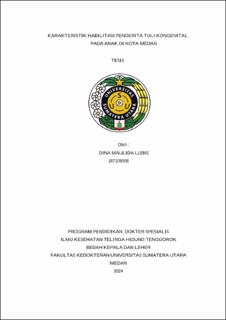Karakteristik Habilitasi Penderita Tuli Kongenital pada Anak di Kota Medan
Characteristics of Habilitation for Congenital Deafness in Children in Medan City

Date
2024Author
Lubis, Dina Maulida
Advisor(s)
Haryuna, Tengku Siti Hajar
Kananda, Vive
Metadata
Show full item recordAbstract
Introduction: Congenital hearing loss in children requires early detection and intervention to support speech and communication development.
Objective: This study aimed to investigate the characteristics of habilitation among children with congenital deafness in Medan, Indonesia.
Method: A cross-sectional descriptive study was conducted using questionnaires administered to 116 mothers of children diagnosed with congenital deafness, complemented by medical records from Adam Malik General Hospital.
Results: The majority of children were male (55.5%), with a mean age of 7.84 years. Most children were diagnosed and habilitated after the age of 1 year, with 83.6% using hearing aids and 90.9% undergoing habilitation for more than 1 year. Speech therapy was provided to 49.1% of children for over 1 year post-habilitation. The predominant communication method was a combination of sign language and oral/verbal (68%), and 83.6% of children attended special schools. Children diagnosed and habilitated before 1 year of age had a higher likelihood of using oral/verbal communication compared to those starting habilitation later. The type of habilitation also influenced communication, with cochlear implant users showing a higher proportion of oral/verbal communication than hearing aid users. Additionally, the duration of habilitation and speech therapy impacted communication development, with children receiving therapy for more than 1 year demonstrating increased chances of oral/verbal communication compared to those with shorter therapy durations.
Conclusion: The findings emphasize the importance of early detection and intervention in supporting the communication development of children with congenital deafness.
Collections
- Master Theses [204]
